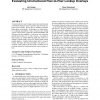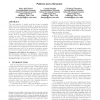92 search results - page 11 / 19 » Drawing Power Law Graphs |
SAC
2006
ACM
14 years 1 months ago
2006
ACM
Unstructured peer-to-peer lookup systems incur small constant overhead per single join or leave operation, and can easily support keyword searches. Hence, they are suitable for dy...
KDD
2004
ACM
14 years 1 months ago
2004
ACM
Many real-world graphs have been shown to be scale-free— vertex degrees follow power law distributions, vertices tend to cluster, and the average length of all shortest paths is...
KDD
2008
ACM
14 years 8 months ago
2008
ACM
The vast majority of earlier work has focused on graphs which are both connected (typically by ignoring all but the giant connected component), and unweighted. Here we study numer...
PODS
2006
ACM
14 years 7 months ago
2006
ACM
The link structure of the Web can be viewed as a massive graph. The preferential attachment model and its variants are well-known random graph models that help explain the evoluti...
WAW
2007
Springer
14 years 1 months ago
2007
Springer
A random graph model based on Kronecker products of probability matrices has been recently proposed as a generative model for large-scale real-world networks such as the web. This...


